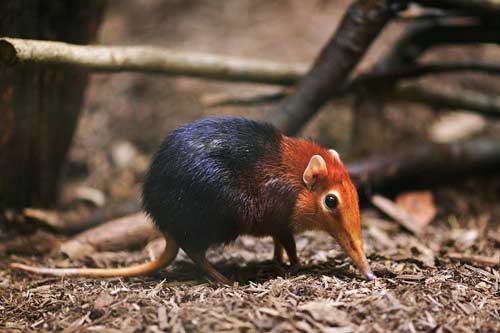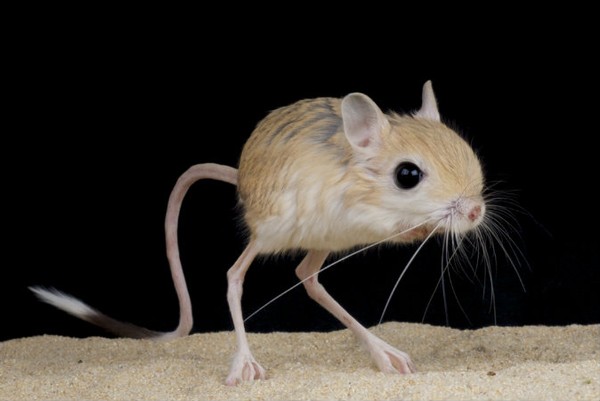The most bizarre animals on Earth
Scientists increasingly have new scientific and discovery information about the natural world, in which there is the strange existence of the most unique animals with bizarre shapes.
>> The most exotic animals on the planet
Explore the incredible and incredible animals in the world
According to scientific information of researchers, the animal world also contains many species that humans and science cannot discover. Prominent among the recent discoveries of scientists are unique animal species with strange shapes.
Elephant shrew
The elephant shrew has a scientific name, Macroscelidea , which has the features of a hybrid elephant-like shape with rats and deer : a mouse-like shape, a long nose like an elephant's cock and a deer-like brown fur. Distributed mainly in southern Africa, this elephant shrew has a size of 10 - 30cm, weighs 50 - 500gr, elongated muzzle, rather long legs.

Scientific information has proved the existence of this strange shaped mouse
Their favorite food is insects such as spiders, centipedes, multi-legged animals, earthworms. Elephant shrews use their noses to find prey and use their tongues to bring food into their mouths, like anteater. They move quite quickly and are very cautious. When they detect a threat, they will disguise themselves by hiding quickly into the bush.
Jerboa
The gerbil, also known as the desert mouse, has the scientific name Gerbillinae, which lives mainly in arid climates in Africa and India.They possess a monstrous appearance with long rabbit ears, a mouse's face and body, and long and strong legs like a kangaroo.

According to scientific information, the shape of the gerbil is adapted to the environment
Although the appearance is somewhat unfortunate compared to other species, jumping rats possess very special abilities. Long legs help them hopscotch like kangaroos. This is the simplest and most effective way to overcome significant distances in the desert because sand is a very easy surface to sink and difficult to walk.
Another striking feature of gerbils is the huge disproportionate size between small body and oversized ears. But this is an evolutionary advantage because this feature helps this species dissipate heat to the air faster, lowering body heat better than short-eared creatures.
Titicaca Frog
Frog Titicaca is the only big frog species found in Lake Titicaca, South America.They have giant layers of pleated skin that can help increase the surface of the body and help them absorb more oxygen . Due to the wide skin layer, they are also known as the scrotum frog Titicaca. This frog is facing a serious risk of extinction by being hunted too much by humans as food, because its habitat is narrowed and invaded by other species.

There is not too much scientific information about Titicaca frog
Grasshopper grasshopper

Hidden porcupines contain unique scientific information about strange looks
The porcupine grasshopper that lives in this Amazon forest area makes us feel surprised when we encounter it because of our very special appearance.On the body of this locust, countless thorns were extremely sharp . But contrary to the bizarre appearance, porcupine grasshoppers are extremely gentle, mostly eating grass and sometimes eating some small insects. Although this species is quite gentle, but you should not try to touch them by the spikes of grasshoppers hedge so sharp that they can pierce skin anyone touched.
Mole rat hair
It looks ridiculous, but hairless rats are superheroes in the animal kingdom.This is one of the only two mammal species that live in populations with mole tribe, which is the only child capable of reproducing and the muscular rat herd, like the life of honey bees.

Mole rat hair
The mole rats dig through the intermittent underground cave system to bring food back to the whole herd. And yet, hairless mice don't have cancer and researchers want to find out why.
- 8 incredible bizarre animals exist in the world
- Decode bizarre stories that happen every time there is Eclipse and Moonlight
- Bizarre mating of animals
- The bizarre two-headed animals
- Discover the land used to have bizarre creatures living
- 13 species of miraculous ancient mammals
- Discover a series of bizarre creatures in the deepest abyss of Earth
- Vetulicolian - Strange creatures have distant relatives with humans
- 'Glimpse' strange monsters exist on Earth
- Animals appear first on Earth
- The world's most bizarre green shrimp
- Recreate the 3-dimensional structure of the oldest animals on earth
 Animal 'suffering' after hibernation
Animal 'suffering' after hibernation Why do goats climb well?
Why do goats climb well? Scientists were surprised to see chimpanzees eating turtles
Scientists were surprised to see chimpanzees eating turtles Giant catfish died deadly due to drought in Thailand
Giant catfish died deadly due to drought in Thailand